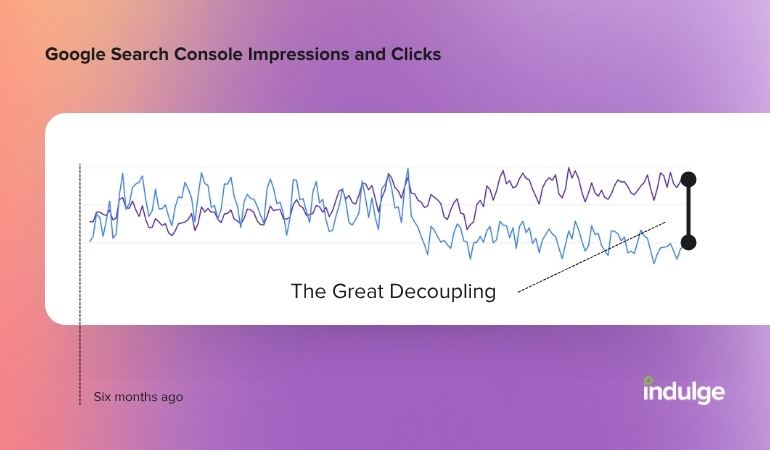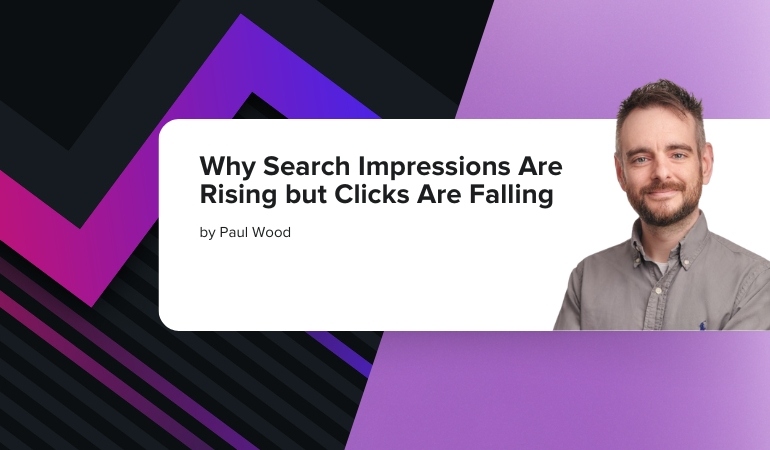TL;DR
- Google’s AI Overviews are changing how searchers engage with websites.
- We’re seeing rising impressions but falling clicks, a trend dubbed “The Great Decoupling.”
- For marketers, this demands a rethink in both content strategy and performance measurement.
Why Search Impressions Are Rising but Clicks Are Falling
Earlier this week, a client asked about their Google Search Console data. Essentially, they observed that impressions have been increasing, but clicks have remained static, if not fallen slightly.
In English, the number of times Google has shown a link to my client’s website has increased, but the frequency of people clicking those links has declined.
Naturally, the question turned to what had gone wrong?
The answer, frustratingly, looks likely to be nothing. Nothing has gone wrong.
It’s called ‘the great decoupling’
Coincidentally, that morning, I’d been doing some reading into the trend my client had observed.
Someone online has given it a name: the great decoupling.
It describes a shift in a previously well-established pattern in Google Search Console. Historically, the Search Console ‘performance’ report would show a graph with clicks and impressions following each other.
When one increases, so too does the other. Occasionally, they would diverge, but by a small amount and for a short period.
Now, though, the pattern that has been in place since the dawn of this type of reporting has changed.

I decided to review a set of sites
Of the 21 sites I looked at, 19 showed signs of this trend. Only two sites looked ‘normal’.
I’ve observed the pattern over the past few months already, but I haven’t reviewed the full scale of the phenomenon until now.
Given we have access to a large collection of Google Search Console profiles, I took a sample of 21 websites spanning multiple sectors: financial services, regulation, professional services, travel, and more.
The sites are also global; some operate regionally, some operate globally. Some are based in the UK and the Channel Islands, and some are based in other jurisdictions.
So, did I observe ‘the great decoupling’ in action?
Yes.
Of the 21 sites I looked at, 19 showed signs of this trend. Only two sites looked ‘normal’.
What’s going on?
This all has to do with the advent of Google’s AI Overviews. You’ll have seen them. When you search for something on Google, the top section of the results page will be devoted to an AI-generated response providing an often compelling answer to your query.
What the so-called great decoupling is showing is that AI Overviews are having a profound impact on search behaviour.
AI Overviews are increasing opportunities for brands to have a link/reference shown in search results, but with the increase in impressions, there’s a lower chance that a person clicks through to the source website.
I noticed a few patterns
19 of the sites I looked at showed this trend playing out, but some much more so than others. The most profoundly affected were the brands that have historically had the most successful content marketing campaigns.
One site in particular that I often look to as the benchmark for how to successfully use content has seen a dramatic growth in impressions but a drop-off in clicks.
My best guess is that Google’s AI Overviews are making good use of the website’s library of resources, but not encouraging readers to visit the source of the information.
Is this bad?
This feels like a bad thing. It feels like writing a novel, only to have the librarian tell every visitor the punchline before they pick up the book.
But is it bad?
Starting with impressions, it’s not necessarily as bad as it may first appear.
Assuming that every reference to a brand’s content in an AI Overview is accompanied by a mention of said brand, this is potentially a net benefit.
It’s harder to track, but if your brand name is tied to a topic, it gains space in the consumer's mind and becomes synonymous with a subject.
That’s a significant ‘if’ though. As a user of Google, I’ve read plenty of AI Overview responses where the source of the information certainly isn’t prominent.
What has Google said?
“We see the clicks are of higher quality, because they’re not clicking on a webpage, realising it wasn’t what they want and immediately bailing,” says Elizabeth Reid, Head of Google Search, in a recent interview with the Financial Times.
“...they spend more time on those sites. We see that it shows a greater diversity of websites that come up.”
It’s quality over quantity that Reid is suggesting.
That’s probably fair when AI Overviews lead to a click. The ‘when’ part is critical, though. A user coming from an AI Overview is likely to be better informed because the information they’ve seen prior to clicking is more in-depth.
Google CEO, Sundar Pichai, has said that “If you put content and links within AI Overviews, they get higher clickthrough rates than if you put it outside of AI Overviews.”
This position is less easy to defend. The data (albeit patchy at the moment) doesn’t bear this out.
From my (very) unscientific review of Search Console, I’m not seeing this pattern.
What does this mean for marketers?
I think there are two key considerations here: should marketers change their approach to content, and should marketers change their approach to reporting?
Content
When it comes to content, for years we’ve encouraged many clients to use content as a key part of their marketing arsenal.
It has been based on a simple assumption: by definition, a successful business operates in a niche, it has a special set of skills that fit with a special segment of the market.
The job of content for these types of organisations is to demonstrate this specialism and outline unique expertise.
As a result, producing educational and informational content for a clear audience works very well as a marketing tool.
There’s plenty of generic information online, but you’d be surprised at the opportunities that continue to exist when an audience’s needs are more bespoke.
AI Overviews essentially disrupt the old journey. Where once a person searches for a particular challenge and is sent to a website with a good response, AI Overviews now attempt to be the response.
I don’t think this means brands should abandon being the source of expertise, though.
I’ve already written about a concept I call ‘responsive information’, and I believe this is the answer. Brands need to produce information with the knowledge that it will be repurposed by generative AI tools.
Reporting
When it comes to analytics and reporting, I think the ‘great decoupling’ is the latest in a long line of trends that are forcing marketers to wake up from the fragile utopia that was full attribution.
It has never really been possible to track every single interaction a person has with your organisation (data sources have always been shaky, and it’s creepy!).
With increasing focus on data and privacy protection (quite rightly), combined with a continuing trend towards the repurposing of information on different platforms and in different formats, attempting to track all of this is folly.
In an article a few weeks ago, I compared this to when a brand launches an OOH (out-of-home) campaign. Brands can’t know exactly how many eyeballs see an OOH message.
What they need to know is how well-known the brand is and how well understood their message is.
I believe the same is going to become true for web-based information. Knowing that a message is reaching the intended audience and is being associated with your brand is what counts.
How we monitor that is going to change, but the challenge remains true.





